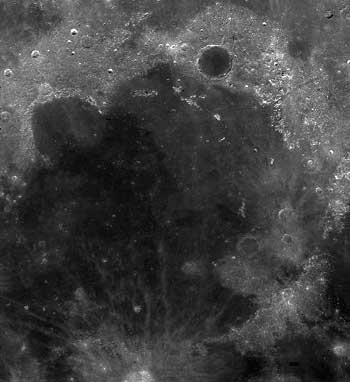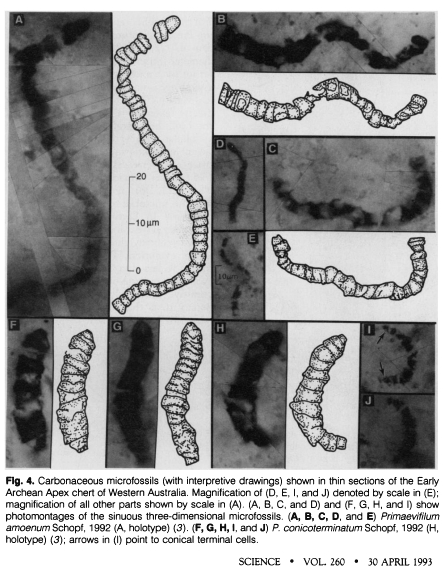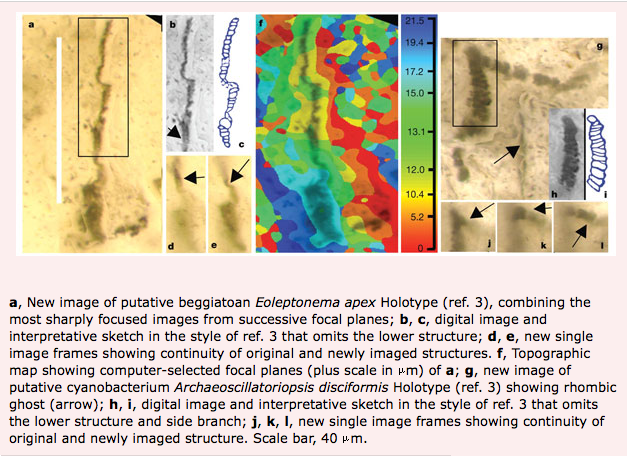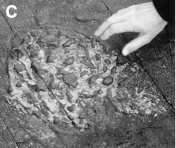CLASS 9. Evolution of the Universe and Life
Timeline for the evolution of the universe
[Toilet Paper version is here](1 billion years BP = 109 = 1,000,000,000 years before present.)
| 8-15 billion years BP (current estimate: 13 billion years BP) |
Big Bang (George Gamow and Ralph
Alpher, 1948) Click here for artist's representation of the big bang theory |
| Stars and star clusters start to form 1 billion
years after the Big Bang. Recent finding indicates that stars formed as early as 300 mln. years after Big Bang Helium is generated from hydrogen in stars, carbon from helium Supernovae explosions generate the rest of the elements from the periodic table and distribute heavier atoms in space Our sun and planetary system form using heavier elements from the supernova explosion 11 billion years BP |
|
| 4.5-5 billion years BP | Earth and Moon form. Here is an essay
on the Age of Earth. Earth was quite different at that time from how it looks today:
"Think of French onion soup with a skin of cheese floating on hot fluid below" [Eyles and Miall, "Canada Rocks", Fitzhenry and Whiteside, 2007] |
| 4.03 billion years BP | Oldest rocks on Earth, located in Canada! (Acasta Gneiss, Northwest Territories). Go here
and here
for details on dating rocks. Some characteristics of these rocks indicate that 4.3 billion years
ago the crust was already in contact with water, more here.
 4.3 billion years old crustal rocks were found embedded in 3.49 billion years old rocks in Pilbara, Australia (news release and article). 4.3 billion years old crustal rocks were found embedded in 3.49 billion years old rocks in Pilbara, Australia (news release and article).
|
| about 4 billion years BP | Mare Imbrium was
formed [Photo is from this NASA web site] |
| about 3.9 billion years BP | End (tail) of the Early Heavy Bombardment |
| 3.85 billion years BP | Oldest known sedimentary rocks, indications for liquid water,
rounded pebbles, and discrimination against heavy carbon isotopes is
detectable in organic material (just like modern biochemical
reactions). Oldest geological evidence for life is based on 13C discrimination (carbon derived from living systems often have lower delta 13C values than inorganic carbonates) [here]. The rocks are from Akilia island off the coast of Greenland, and severely altered by metamorphism. However, recently the evidence for that was reassessed. |
| 3.5 billion years BP | For about a decade the oldest microfossils were considered
to be about 3.5 Ga old (see
here). The fossils (as interpreted by Bill Schopf) look like
"modern" Cyanobacteria [bacteria that have O2 producing
photosynthesis].  However, recently the evidence for these fossils was questioned: 
|
about 3.45 billion years BP  |
Formation of earth's magnetic field. Magnetic field is important for life forms, as it shields the planet against the solar wind and radiation. "Without such a magnetic field, the atmosphere would have been exposed to ionization and erosion by the charged particles in the solar wind, and any form of early life would have been irradiated by the intense x-ray and high-energy ultraviolet emission from the young Sun." [Source] |
3.2 billion years BP  |
acritarchs from rocks of the Moodies Group of South Africa. Relatively large in size (300 micrometres) and it is not known from which domain of life they are (Javaux, 2010) |
| 3.2 billion years BP | filamentous fossils, probably of thermophilic chemotrophic prokaryotes (Rasmussen, 2000) |
| 2.7 billion years BP | probable biomarkers of cyanobacteria and of eukaryotes (Roger Summons, Roger Buick and Jochen Brocks) |
| 3.5 (?) -1.5 billion years BP | microbial mats (-> stromatolites) dominate the biosphere [What are Stromatolites?] |
| 2 billion years BP | Rise in atmospheric O2 |
| 1.8 billion years BP | fossils from Gunflint formation: iron-loving bacteria and cyanobacteria |
| 1.2 billion years BP | fossil red algae (bangiophytes)

Fig. Comparison of fossil
filaments (A to C) with
modern Bangia atropurpurea (D to F)
[Source] |
| 750 million years BP |
Possible "Snowball Earth"
event: Illustration and Timing Scientific American article by Hoffman and Schrag on "Snowball Earth" - Ice entombed our planet hundreds of millions of years ago, and complex animals evolved in the greenhouse heat wave that followed." Also, a recent book is highly recommended: "Snowball Earth: The Story of the Great Global
Catastrophe That Spawned Life As We Know It" by Gabrielle Walker,
Crown Publishing Group, 2003  Recent criticisms (2010): here. Recent criticisms (2010): here.
|
Ediacaran Biota - A group of multicellular complex organisms
(all extinct). More info: here and
here

Fig. "Pizza Disc", Mistaken Point, Newfoundland.
[Source] |
|
| 600 million years BP | Cambrian explosion -> origin of the different animal phyla |
Scale of the Universe
- The closest star to Earth (aside from our own Sun) is Proxima Centauri in Alpha Centauri system. It is 4.3 light-years away.
- The closest galaxy to our Milky Way is Sagittarius Dwarf Elliptical Galaxy. It is 80,000 light-years away.
- The closest spiral galaxy to our Milky Way is Andromeda, a galaxy much like our own Milky Way. It is 2.2 million light years away from us.
- The visible Universe is 14 billion light-years. The map of the visible Universe is here
